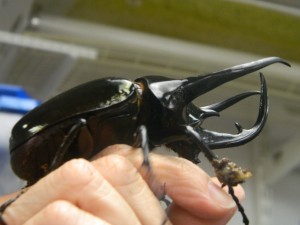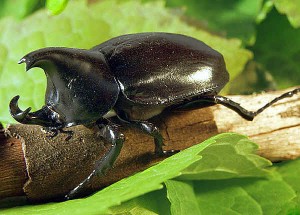Coming to a butterfly garden, I didn’t expect this.
In a place where colorful, graceful, and beautiful creatures flutter freely, who knew this beast could be living right next door? As I got to go “behind the scenes” of the natural science museum in Houston, Texas, I saw for the first time an insect that just did not look like it could be real. Perhaps in a sci-fi horror film where large, disgusting insects take over the cities, or maybe in prehistoric times when were centipedes as large as automobiles, but certainly not now, in 2013, in a back room of a science museum.
It was called the Japanese rhinoceros beetle, and it was the most terrifying insect I had ever seen in real life. It was huge; its width was the entire size of a human palm. It was jet black, with two large horns that looked like pincers sticking out of its head. You can imagine my surprise when the woman who had brought me to the room confidently stuck her hand into its cage and scooped it right up.
No, those weren’t pincers. It was not aggressive, nor evil, and did not attack anybody in the room. Instead it calmly sat on her palm, letting everyone in the room caress its black body.
What was the point of those deadly looking horns if not used for clamping onto threats or meals? As it turns out, the horns themselves are worn by males mainly just for show. Here, we see a wonderful example of sexual selection.
In this article from Discover Magazine, Ed Yong states that “the growth of the horns is intimately tied into molecules that reflect how well-nourished the beetles are”, and thus “females can rely on the size of the horns to judge a potential partner’s health”. So, the bigger the horn, the more potential for mating! And, as we know, there is nothing an insect likes more than to mate (along with eating).
So just how large can these horns grow? According to Stephanie Pappas, some males grow horns up to two-thirds their body size! That is ridiculously massive. To put that in perspective, that would be like the average 5’10” human male having horns on his head that extended nearly 4 feet!
It would seem as though with such huge horns, perhaps the mobility or flight of the beetle may be at a disadvantage. (Wouldn’t you expect a man with 4 foot horns sticking out of his head to be maybe just a little bit impaired?) This, however, does not seem to be the case with the rhinoceros beetle. In this scientific journal, it is explained how testing was done on rhinoceros beetles to come to this conclusion. McCollough chose rhinoceros beetles who had horns about two-thirds their body length. After euthanizing them, she weighed them with and without their horns. She also determined the center of mass of the beetles with and without their horns, as well as how the horns affected drag on the beetles’ bodies.
The findings were a surprise! The horns were very dry and hollow, making up only .5%-2.5% of the beetles’ body weight. Thus, they hardly changed the beetles’ center of mass. The beetles fly slowly with their bodies almost vertical; in such a position, the horns do not affect the flying at all.
So beetles with the biggest horns get the females AND don’t have to pay for it? Sounds like the best of both worlds to me. It seems as though in the insect world, sometimes the beast does, in fact, win over the beauty.
To see more picture of the amazing rhinoceros beetle, you can go here.


